This document presents a Bluetooth quizzing application for Android, designed to enhance educational interactions by allowing lecturers to administer quizzes to students. The application includes a server and client component, facilitating simultaneous connections and automatic result analysis to improve student engagement and learning outcomes. The findings suggest that the application effectively addresses issues such as low attendance and pass rates in educational contexts.

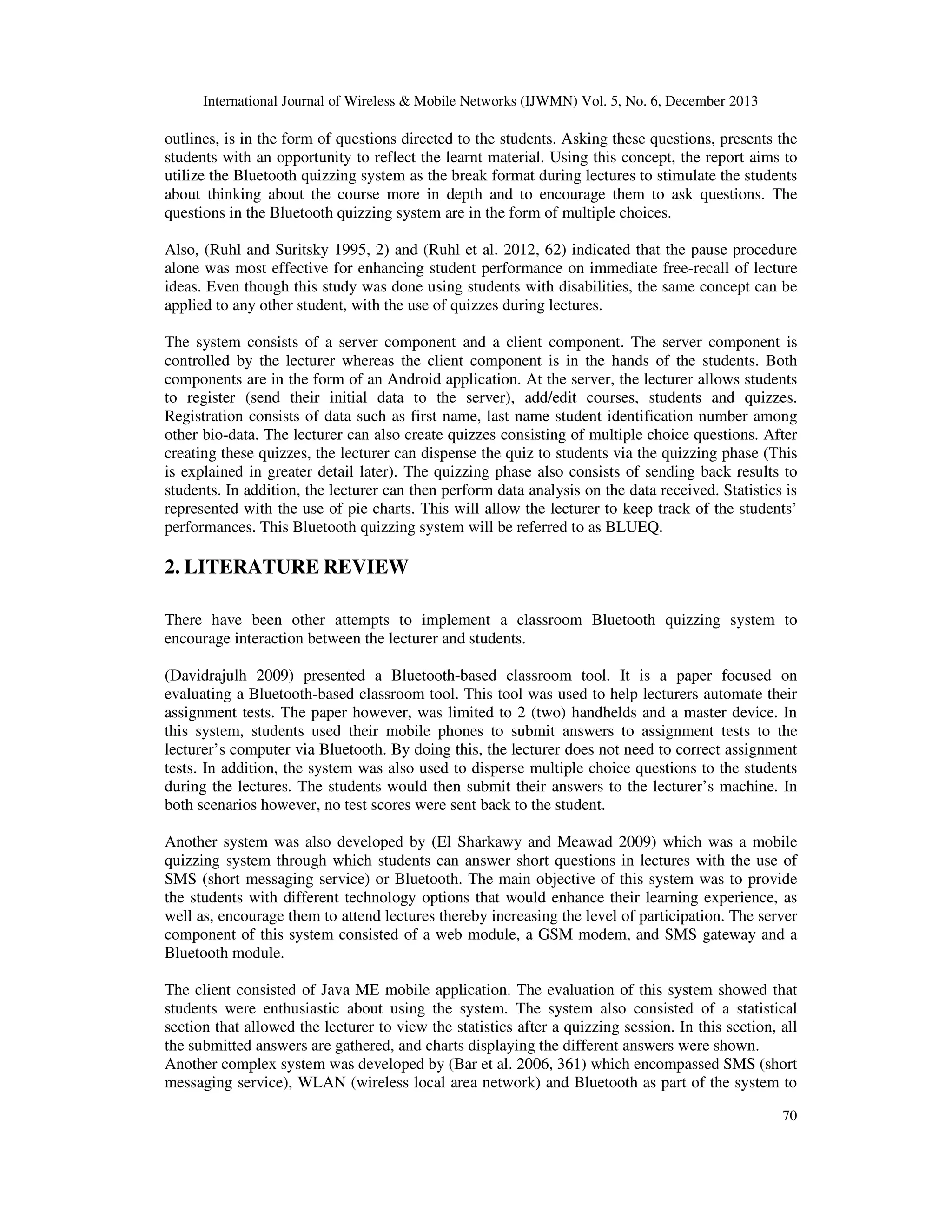

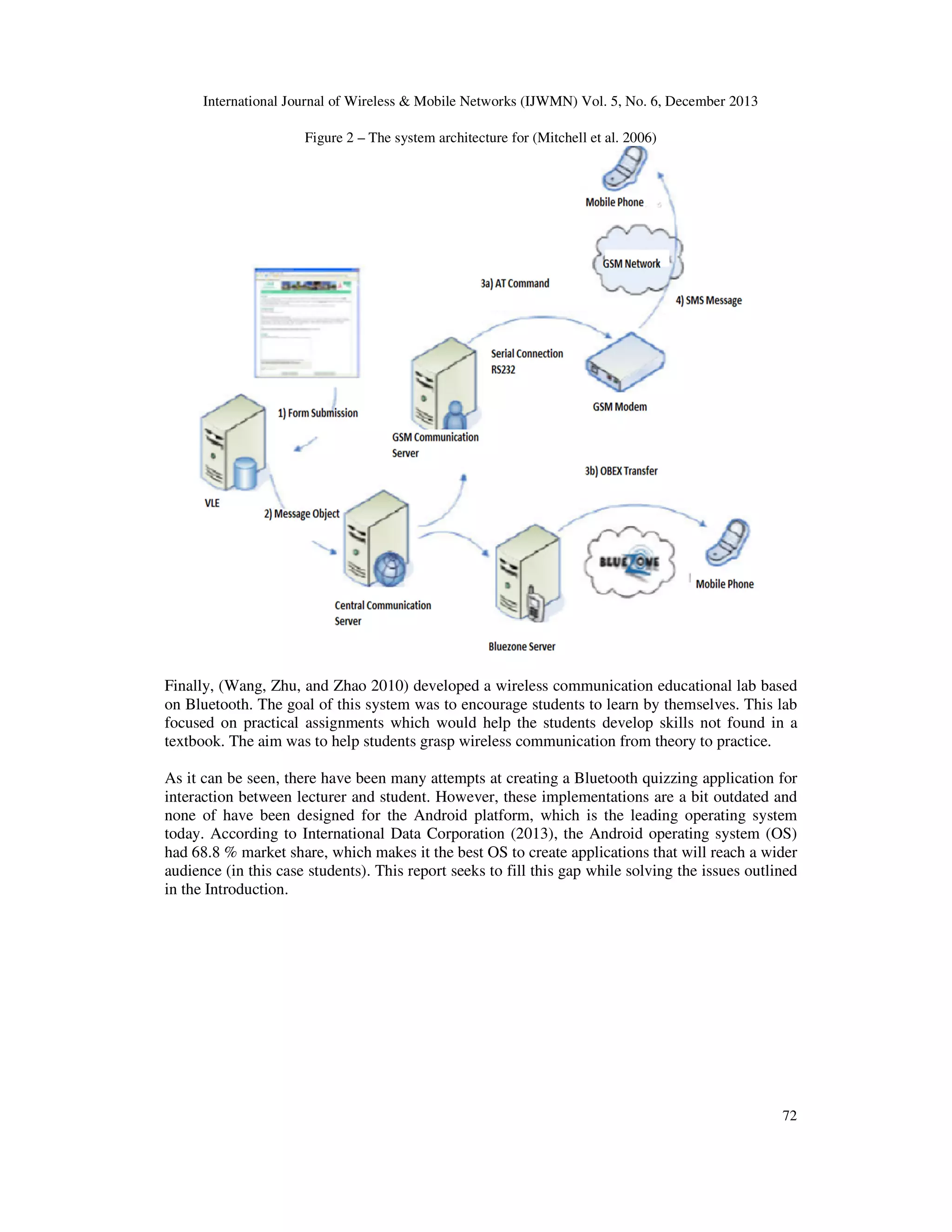
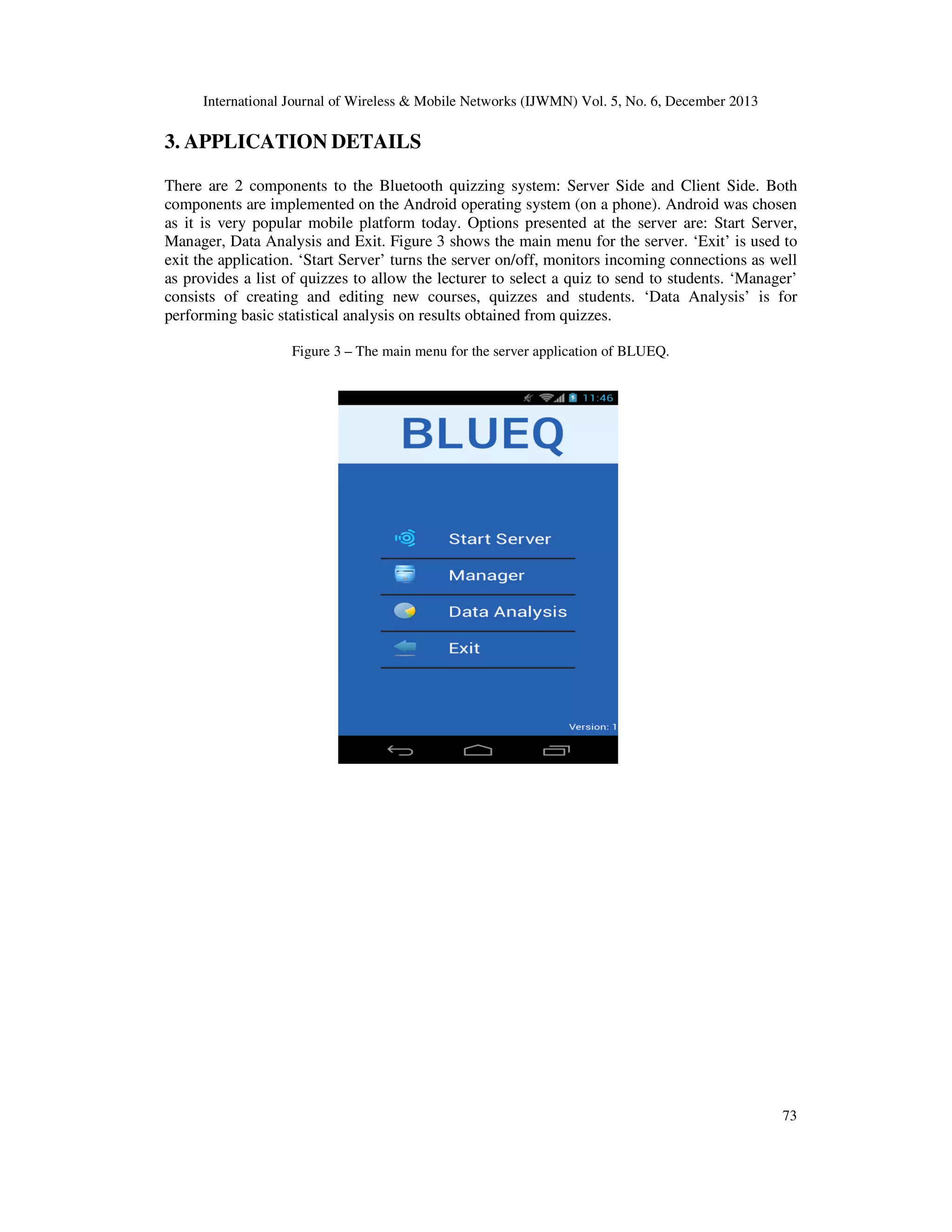

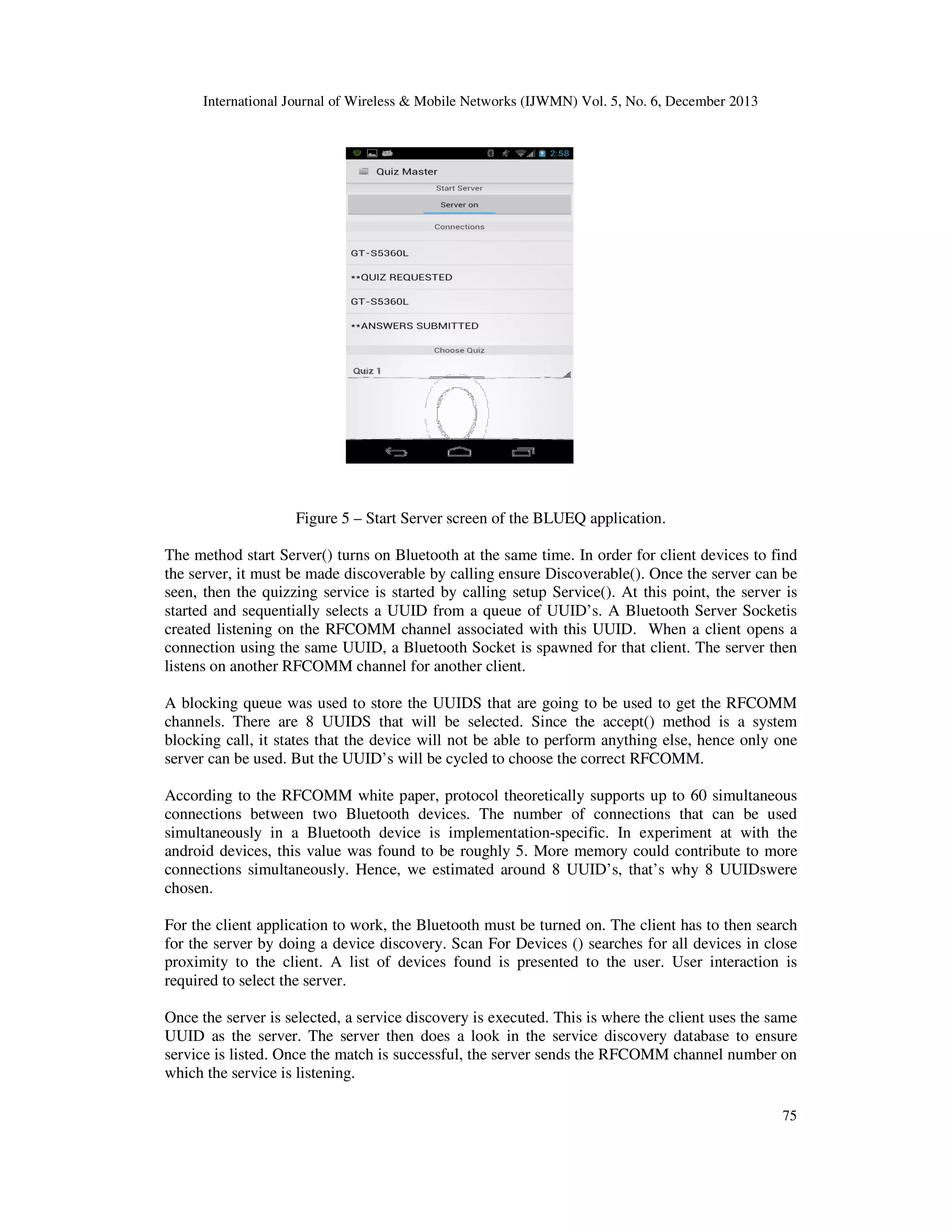
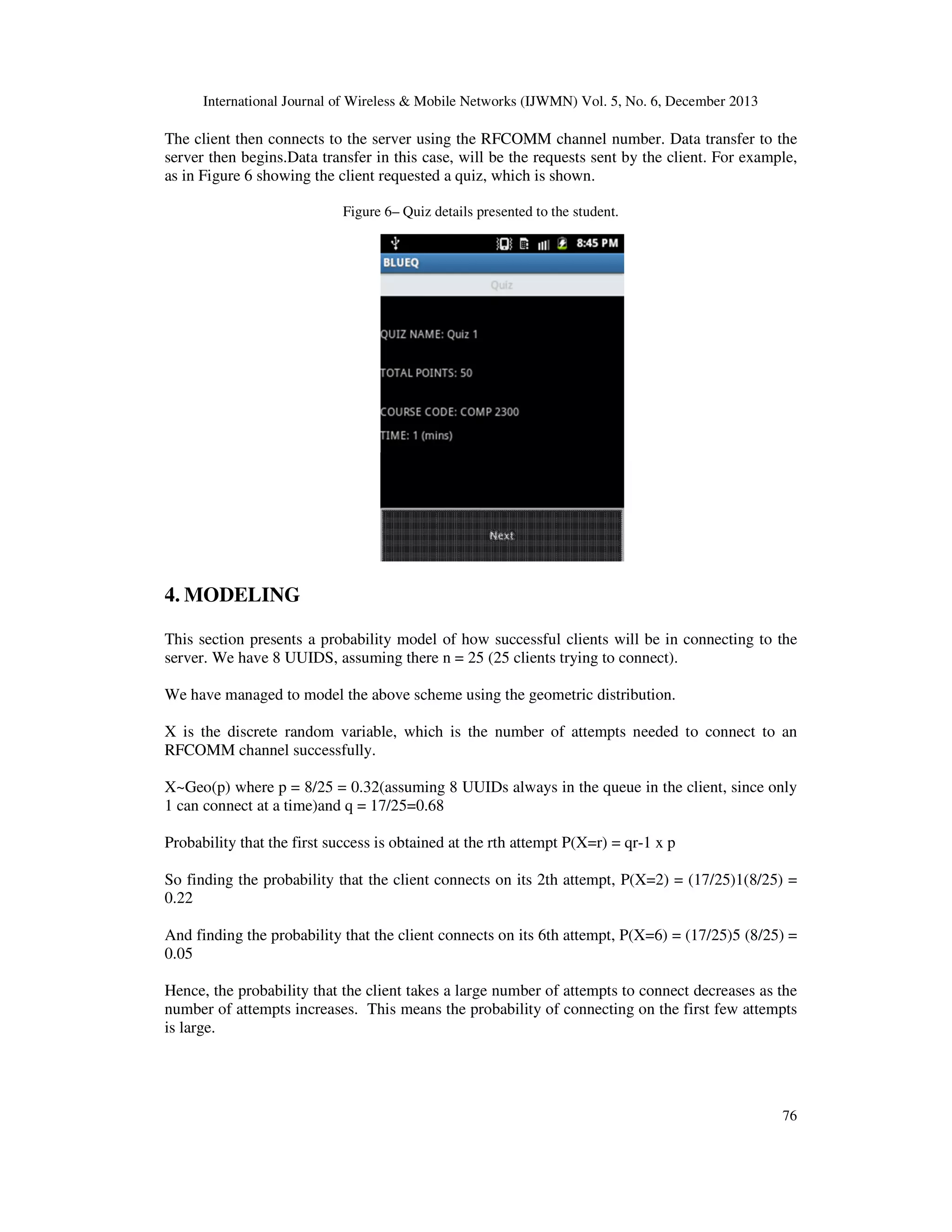
![International Journal of Wireless & Mobile Networks (IJWMN) Vol. 5, No. 6, December 2013
5. CONCLUSION
A Bluetooth quizzing application was developed for use in lectures, to help lecturers administer
quizzes and in turn help students revise work previously learnt. Students will benefit by revising
work done in previous classes.
The queuing method of UUID’s proved to be very useful due to the constraints of the Bluetooth
technology. The probability of taken too many attempts was found to be very small.
Future works could improve on this method for supporting more simultaneously Bluetooth
connections on the server side. Also, the means of communicated can be improved by using XML
to structure messages passed between client and server.
REFERENCES
[1]
[2]
[3]
[4]
[5]
[6]
[7]
[8]
[9]
[10]
[11]
[12]
[13]
[14]
[15]
[16]
[17]
Android
Developer.
2013.
“Bluetooth
Adapter”.
Accessed
June
11,
2013.
http://developer.android.com/reference/android/bluetooth/BluetoothAdapter.html.
Atmel Coporation .1991.The Bluetooth Wireless Technology. Atmel Corporation
Bär, Henning, Gina Häussge, and Guido Rößling. 2007. “An Integrated System for Interaction
Support in Lectures.” ACM SIGCSE Bulletin 39 (3): 281. doi:10.1145/1269900.1268865.
Bär, Henning, Guido Rößling, Erik Tews, and Elmar Lecher. 2006.
“Bluetooth Interaction Support in Lectures.” In Proceedings of Mobile Learning, 2006, 360364.IADIS Press.
Bluetooth Special Interest Group. 2009. Specificiation of the Bluetooth System, Core Version 3.0.
Accessed August 24, 2012. https://www.bluetooth.org/en-us/specification/adopted-specifications
Davidrajuh, Reggie. 2009. “Evaluating Performance of a Bluetooth-Based Classroom Tool.”
International Journal of Mobile Learning and Organisation 3(2): 148-163. doi:
10.1504/IJMLO.2009.024424.
Zhang, Guoliang, Ningbo Univ, Ningbo, FengXiong, and Qi Luo. 2007. “Mobile English Assistant
Learning System Based.” In 2nd International Conference on Pervasive Computing and Applications,
26-27 July, 2007, 689 - 692. Birmingham.
Hosny, W. 2007. “Power Engineering Mobile Education Technology.” 2007 42nd International
Universities Power Engineering Conference, 4-6 September, 2007, 971–974. Brighton.
Hopkins, Bruce, and Ranjith Antony. 2003. Bluetooth for java .Apress.
Huang, Albert S., and Larry Rudolph. 2007. Bluetooth essentials for programmers.Cambridge
University Press.
International Telecommunications Union. 2011. “Mobile Cellular telephon subscriptions.” Accessed
May
24,
2013.http://www.itu.int/ITUD/icteye/Reporting/ShowReportFrame.aspx?ReportName=/WTI/CellularSubscribersPublic&ReportF
ormat=HTML4.0&RP_intYear=2011&RP_intLanguageID=1&RP_bitLiveData=False.
International Data Corporation. 2013. “IDC – Press Release.” Accessed May 24, 2013.
http://www.idc.com/getdoc.jsp?containerId=prUS23946013#.UTCOPjd4DlY
Miller, Michael. 2001.DiscoveringBluetooth.Sybex Incorporated.
Mitchell, Keith, Nicholas P. Race, Duncan McCaffery, Mark Bryson, and Zhen Cai. 2006. “Unified
and Personalized Messaging to Support E-Learning.” 2006 Fourth IEEE International Workshop on
Wireless, Mobile and Ubiquitous Technology in Education,16-17 November, 2006, 164–168. Athens.
Kammer, David, Gordon McNutt, Brian Senese, and Jennifer Bray. 2002. Bluetooth application
development guide: The short range interconnect solution. Syngress Publishing Incorporated.
Korucu, AgahTugrul, and AyseAlkan. 2011. “Differences Between M-learning (mobile Learning) and
E-learning, Basic Terminology and Usage of M-learning in Education.” 3rd World Conference on
Educational Sciences, 2011,1925-1930.
Kumar, C. Bala, Paula J. Kline, and Timothy J Thompson. 2004.Bluetooth application programming
with Java API. Elsevier Incorporated.
77](https://image.slidesharecdn.com/aneducationalbluetoothquizzingapplicationinandroid-140108210315-phpapp01/75/An-educational-bluetooth-quizzing-application-in-android-9-2048.jpg)
![International Journal of Wireless & Mobile Networks (IJWMN) Vol. 5, No. 6, December 2013
[18] Rößling, Guido, Ari Korhonen, Rainer Oechsle, J. Ángel Velázquez Iturbide, Mike Joy, Andrés
Moreno, AtanasRadenski, et al. 2008. “Enhancing Learning Management Systems to Better Support
Computer Science Education.” ACM SIGCSE Bulletin 40 (4): 142. doi:10.1145/1473195.1473239.
[19] Ruhl, Kathy L, Charles A. Hughes, Anna H. Gajar, Kathy L Ruhl, Charles A. Hughes, and Anna H.
Gajar. 2012. “Efficacy of the Pause Procedure for Enhancing Learning Disabled and Nondisabled
College Students ’ Recall Long- and Short-Term Facts Presented Through Lecture.” Learning
Disability Quarterly 13 (1): 55–64.
[20] Ruhl, Kathy L, and Sharon Suritsky. 1995. “The Pause Procedure And / Or An Outline : Free Recall
Effect On Immediate And Lecture Notes Taken by College Students with Learning Disabilities.”
Learning Disability Quarterly 18 (1): 2–11.
[21] Sharkawy, Bahia Fayez El, and FatmaMeawad. 2009. “Instant Feedback Using Mobile Messaging
Technologies.” 2009 Third International Conference on Next Generation Mobile Applications,
Services and Technologies, September: 539–544. doi:10.1109/NGMAST.2009.93.
[22] Wang, Qing, Xiuxin Zhu, and Gaoxing Zhao. 2010. “Wireless Communication Educational Lab
Construction Based on Bluetooth.” 2010 5th International Conference on Computer Science &
Education. August: 1574–1577. doi:10.1109/ICCSE.2010.5593770.
[23] Zhang, Yanhui, Wu Li, and Yingzi Fu. 2007. “A Mobile Learning System Based on Bluetooth.” Third
International Conference on Natural Computation, August: 768–771. doi:10.1109/ICNC.2007.64.
[24] Zhang, Yonghong, Shiying Zhang, Son Vuong, and Kamran Malik. 2006. “Mobile Learning with
Bluetooth-based E-learning System.” Proceeding of the 2005 2nd International Conference on
Communications and Mobile Computing – IWCMC, 15-17 November, 2005, 5. Guangzhou.
78](https://image.slidesharecdn.com/aneducationalbluetoothquizzingapplicationinandroid-140108210315-phpapp01/75/An-educational-bluetooth-quizzing-application-in-android-10-2048.jpg)